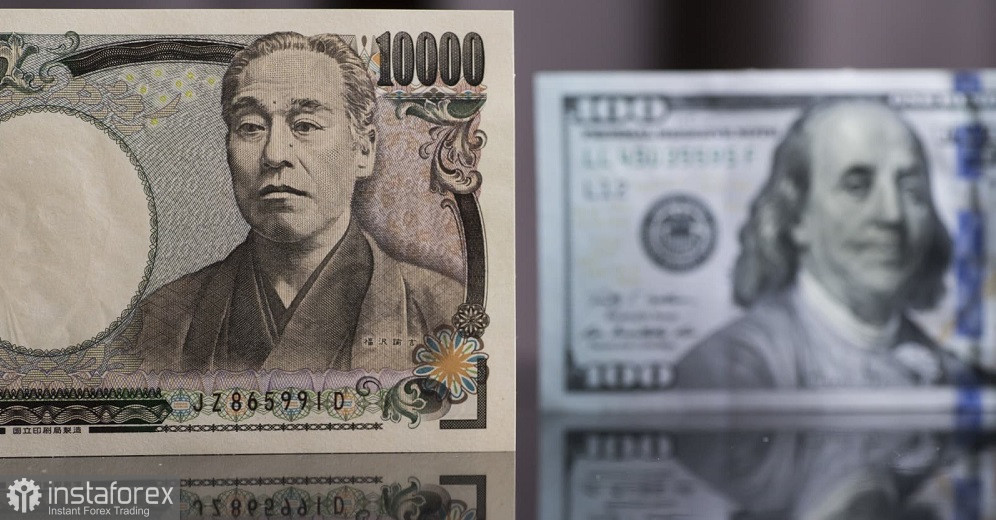The USD/JPY pair updated its monthly high, approaching the middle of the 134th figure. This is primarily due to the dollar's behavior. Despite the disappointing retail sales report, the greenback strengthened its positions across the market on Friday, including against the yen. Now the pair is going by Friday's momentum.
Ups and downs of USD/JPY
In general, since the beginning of February, the pair has been trading in a wide 500-point range. Initially, the price rose to the area of 135-136 figures (impulsively marking at 137.92), then turned down and returned to the value of 130.50. However, the bearish momentum faded here: the bears failed to enter the area of the 129th figure, afterwards the pair again turned 180 degrees and rose to the current local high.

It is noteworthy that the ups and downs of the pair were caused not only by the strengthening/weakening of the dollar but also by the yen's behavior. At the beginning of the year, the yen "lived in anticipation" of changes in the policy of the Japanese central bank, as Haruhiko Kuroda, who had been in charge of the central bank for 10 years, was preparing to retire. Most of his possible successors voiced rather hawkish stances, advocating for the normalization of monetary policy. However, in the end, the choice of the Japanese authorities fell on Kazuo Ueda, who stated that he intends to continue adhering to the large-scale easing program of the central bank's monetary policy. Ueda believes that inflation growth is mainly related to rising import prices, not increasing demand. Speaking in parliament, he expressed confidence that price growth factors "will likely slow down soon," and inflation will fall to below 2% by the end of the current year. At the same time, Ueda reiterated Kuroda's phrase that the benefits of the current monetary policy outweigh its drawbacks.
Although the new head of the Bank of Japan admits the possibility of calibrating monetary policy, he made it clear that any changes would be carried out unhurriedly, consistently, and smoothly: there will definitely be no sharp rate hikes in the spirit of the Fed-2022. Just the day before yesterday, speaking at the G20 summit, Ueda once again reiterated that the BOJ will maintain a loose monetary policy in the foreseeable future.
In the context of such rhetoric, the yen came under pressure, which intensified after the release of the latest inflation report in Japan. The report released at the end of March reflected a sharp slowdown in core inflation in February. The consumer price index, excluding food prices but including oil product prices, grew by 3.1%, after January's growth of 4.2%.
In other words, at the moment, the yen does not have any "own" arguments to strengthen its positions. Against the dollar, the Japanese currency focuses on the dollar's behavior, which in turn reacts to the rise/fall of hawkish sentiment regarding the Federal Reserve's further actions. For example, on Friday, the US dollar index rose amid a statement by Fed representative Christopher Waller, who said that the central bank had not made significant progress in achieving its inflation target, so "the rate needs to be raised further." After this, the likelihood of a 25-point rate hike at the May meeting increased to 84% (according to data from the CME FedWatch Tool). At the same time, dollar bulls ignored the disappointing retail sales data, which was also published on Friday.
Conclusions
Despite the fact that after the events of March (the collapse of several large banks in the US), the Fed significantly softened its position, the Fed's policy still remains more hawkish compared to the policy of the BOJ. The new head of the BOJ continues Kuroda's policy, and core inflation in Japan has sharply decreased. All this suggests that the yen, in the USD/JPY pair, will continue to follow the greenback. Hawkish statements by Fed representatives will provoke upward spikes in the USD/JPY pair, although such fundamental factors have a very short "shelf life". Therefore, the current upward cycle in the short term may fade around the nearest resistance level of 135.00.
From a technical perspective, on the daily chart, the pair is located at the upper line of the Bollinger Bands indicator but is still within the Kumo cloud. The nearest resistance level (the target for the upward movement) is located at the 135.00 mark (the upper limit of the cloud). If bulls overcome this target, the Ichimoku indicator will form a bullish "Parade of Lines" signal, signaling the further development of the uptrend in the medium-term.
 English
English 
 Русский
Русский Bahasa Indonesia
Bahasa Indonesia Bahasa Malay
Bahasa Malay ไทย
ไทย Español
Español Deutsch
Deutsch Български
Български Français
Français Tiếng Việt
Tiếng Việt 中文
中文 বাংলা
বাংলা हिन्दी
हिन्दी Čeština
Čeština Українська
Українська Română
Română

